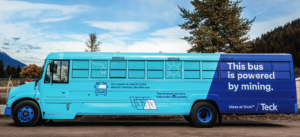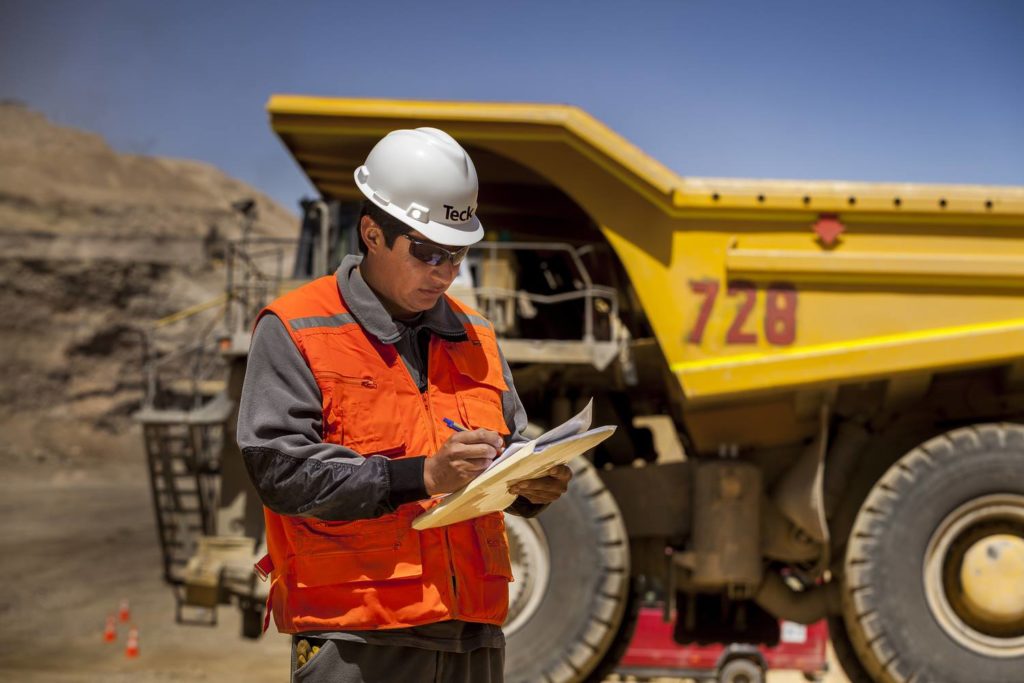Teck is cementing its position as a global mining major – it is the world’s largest net zinc miner & second largest steelmaking coal producer plus will double its copper production by 2023 as Quebrada Blanca 2 comes online. In its just released TCFD-aligned Climate Change Outlook 2021 report, Teck outlines how it will continue to create shareholder value by producing metals and materials that are essential for a low–carbon future while also taking steps to reduce emissions to achieve the goal of being a carbon–neutral operator by 2050.
The report contains some interesting reviews of the company strategy to achieve lower emissions, including through mining fleet electrification. Along with other mining majors Teck argues that shifting to electric-powered mining equipment presents an opportunity for the mining industry to reduce mine site carbon emissions.
Teck states: “As we move towards low-carbon material movement, low-carbon electricity is likely to play a significant role. One of Teck’s advantages is having access to low-cost, low-carbon electricity where, under the appropriate conditions, electrified equipment could potentially deliver lower operating costs than traditional diesel-based solutions. In the early years of equipment electrification, while it is likely that capital costs might be higher than current diesel-based alternatives, projections suggest that electric vehicles will deliver a lower TCO. Furthermore, as electric vehicles reach capital cost parity, the TCO benefits of electrification will only increase. The development and presence of sufficient low-carbon electricity generation and transmission will also be critical to leveraging electrification as a means of decarbonisation. Uncertainty remains as to how these cost structures will evolve over time; however, our strategy to decarbonise contemplates the impacts of energy supply chain constraints and costs.”
On Scope 2 emissions it is making progress. “At our Quebrada Blanca Operations, we are currently sourcing 30% of our total energy needs from solar power, and in 2020, we entered into a long-term power purchase agreement for our Quebrada Blanca Phase 2 project. Once effective, more than 50% of total operating power needs at Quebrada Blanca Phase 2 are expected to be from renewable sources. We have also entered into a long-term power purchase agreement to provide 100% renewable power for our Carmen de Andacollo Operations in Chile. The Carmen de Andacollo renewable power arrangement took effect in September 2020 and will run through to the end of 2031. This action will result in significant emissions reductions at Carmen de Andacollo by eliminating nearly 80% of its operating (ie Scope 1 and Scope 2) emissions.”
On Scope 1, Teck’s primary focus for the remaining emissions cuts required to achieve its interim 2030 goal of a reduction in the carbon intensity of its operations by 33% is on addressing diesel consumption in its mobile equipment. At its mining sites, it is already advancing several projects to assess the viability of electric mobile equipment. “In 2020, at our Highland Valley Copper Operations, we trialled an electric boom truck designed for underground operation. At our Elk Valley Operations, we continue to implement the electric crew bus pilot project, with promising results; in 2021, we have placed orders for more buses and are investing in electrical upgrades that will provide sufficient capacity for further expansion of the fleet.”

The intention with the electric bus pilots from the outset—in addition to decarbonising the buses themselves—has been to gain experience with these technologies, experience that could be transferred to how we evaluate and adopt larger and more mining-specific pieces of equipment. Teck said: “This is now translating
into piloting technologies in larger classes of vehicles to further understand how they operate under conditions different from the buses, where there is continuous operation over longer periods of time, which will in turn require different battery charging strategies and energy management.”
Teck adds that it has also learned that it can accelerate innovation by working with others facing similar challenges. “We’re working with industry groups like the International Council on Mining and Metals (ICMM) on an initiative [Innovation for Cleaner, Safer Vehicles] to work collaboratively with original equipment manufacturers (OEMs) to reduce GHG emissions from large mobile mining equipment (eg haul trucks). This engagement – including the world’s largest mining and metals companies and our key OEMs – brings together the key suppliers and purchasers of mining equipment to tackle one of our most material sources of GHG emissions.” In 2021, Teck also became a member of Electric Mobility Canada, a national membership-based not-for-profit organisation dedicated exclusively to the advancement of e-mobility.
“Working with these partners reflects our commitment to deploying emerging carbon abatement technology at appropriate points in the life cycle of our operation, and also to undertaking research and development of new emission abatement technology. Innovation is part of Teck’s history, and we believe it will play an even larger role in our future as we look for newer and better ways to reduce our GHG emissions. However, the path to decarbonising equipment is not without
challenges. We remain committed to overcoming these barriers through collaboration across our industry, piloting the latest technology and staying agile to take advantage of low-carbon technologies as they emerge.”
In some cases, Teck adds that emerging options are more appropriately suited for its value chain partners, but these may also serve as a stepping stone to applications at its operations. “One such opportunity arose in trucking concentrate from our Highland Valley Copper Operations to Ashcroft, BC, where the concentrate is loaded on rail for further transportation. Working together with our partner, an electric concentrate truck has been purchased to pilot the suitability of this technology for the specific application. Our initial analysis suggested that it was the most promising application of a battery electric vehicle of this class. Not only will this pilot help to reduce GHG emissions in our value chain, but if successful, this technology may be applied in equipment at our operations. The pilot will take place throughout 2022, t which time the results will be analysed to inform future equipment decisions.” IM previously revealed that this involves a Western Star 4900 tractor converted to battery electric operation by MEDATech using its innovative ALTDRIVE technology.

The company also believes it is possible to amplify and accelerate emissions reductions via innovation integration. “One example today is our use of orebody knowledge technologies such as smarter shovels, where sensors and analytics are leading to improved mill productivity, reduced energy use and less water consumption. A second example of innovation and decarbonisation is autonomous vehicles. As autonomy becomes more proven in mining, it may enable the use of different types and sizes of equipment, which in turn will enable different low-emissions alternatives. While fully battery electric ultra-class haul trucks
are yet to become commercially available, smaller classes of haul trucks and mining equipment are available. This in turn suggests that one alternative to today’s approach could be the use of larger numbers of smaller autonomous haul trucks combined with a loading system that leverages the orebody knowledge technologies discussed above. This approach could result in the adoption of battery electric vehicles at a faster pace while also delivering cost and footprint benefits. While it is too early to say whether or not this alternative approach to mining will ultimately be fruitful, we believe that this type of thinking and exploration is critical in helping to
identify and progress emissions reductions at the magnitude that are required.”












